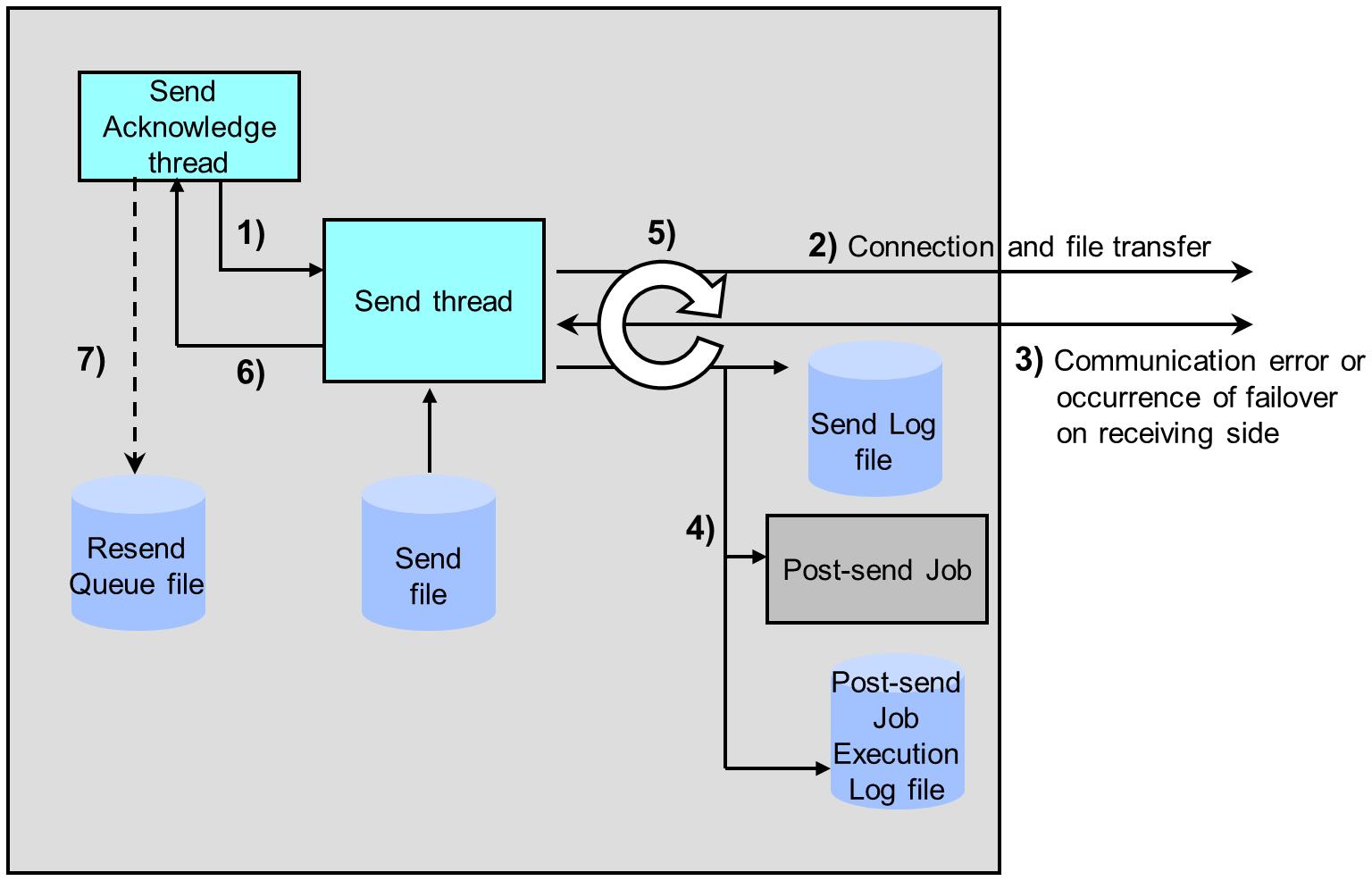Auto Resend
If a network-related error or a forced stop due to a failover occurs during a file transfer, HULFT can carry out resending automatically. At the time of an unsuccessful transfer, it is possible to transfer the data from the point where the error occurred (Checkpoint Resend File) by carrying out resending.
(1) Flow of Auto Resending
The flow of auto resending is illustrated in Figure 2.7 .
1) Starting up the Send thread
The Send Acknowledge thread starts the Send thread.
2) Connecting to the Receive Acknowledge thread
The Send thread connects to the Receive Acknowledge thread and then transfers the file. If the Send thread cannot connect to the Receive thread, it repeats the connection process the number of times specified in Connect Retry Count (retrycnt) in the System Environment Settings.
3) Communication error or occurrence of failover on the receiving side
If an error occurs somewhere along the communication line during file transfer, or if a forced stop occurs due to a failover, the Send thread detects an error and discontinues the processing.
4) Writing the result to the Send Log file and starting up the Post-send Job
The Send thread writes the result on the communication error (failure) to the Send Log file (hulsndlog.db), and starts the job that has been registered as an unsuccessful job.
5) Auto Resend
If an error occurs in 3) , the Send thread waits for the duration that is specified for Connect Retry Interval (retrytime) in the System Environment Settings. Then, it repeats steps 2) - 4) the number of times that is specified for Auto Resend Retry Count (sockerr_autoretry) in the System Environment Settings.
6) Sending a notification of the send result
The Send thread notifies the Send Acknowledge thread of the send result.
7) Registering information in the Resend Queue file
The Send Acknowledge thread writes the information on the transfer in the Resend Queue file (sddreqls.dat) when the send result that was received from the Send thread is unsuccessful.
-
By executing the Resend File command (utlsend.exe), you can manually carry out resending for records that are written in the Resend Queue file.
-
If a communication error occurs in 3) , the Receive process ends the Receive thread and the Receive Acknowledge thread on the receiving side which terminates the transfer. The Receive Acknowledge thread is generated again when reconnected to from the Send process for auto resending.
(2) Auto Resend Error Code
HULFT carries out auto resending for the following error codes:
Error codes when a communication error occurs
If a communication error occurs during sending, one of the following system-related Status codes is recorded in the Send Log:
- 731:
-
The Send processing failed.
- 732:
-
The Receive processing failed.
- 735:
-
Timeout occurs in the Receive processing of data.
Error codes when a failover occurs on the receiving host and the host is forcibly stopped
If a failover occurs on the host on the receiving side, one of the following error codes is recorded in the Send Log:
- 450-591
-
- 450:
-
Status code of the Send process (An error occurred at the host on the receiving side)
- 591:
-
Status code of the host on the receiving side indicating that it was forcibly terminated
For details, refer to Error Codes and Messages of the host type on the receiving side.
A forced stop due to a failover on the host on the receiving side can be detected if the following products are installed on the host:
-
HULFT for UNIX/Linux
-
HULFT for Windows Ver.7.3.0 or higher
Error codes when a data verification error occurs on the receiving-side host
If a data verification error occurs on the receiving-side host, one of the following error codes is recorded in the Send Log:
- 450–535
-
- 450:
-
Status code of the Send process (An error occurred at the host on the receiving side)
- 535:
-
Status code of the receiving-side host indicating that a data verification error occurred
For details, refer to Error Codes and Messages of the host type on the receiving side.
